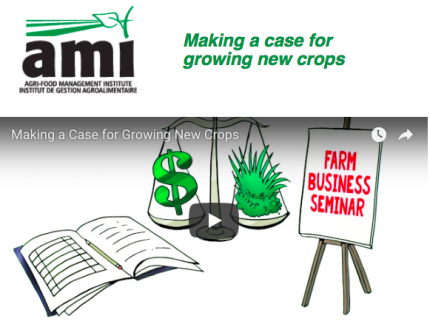New online resource available to Ontario farmers: Making a Case for Growing New Crops
Posted: October 25, 2017
Categories: GoodFoodBites / News from Sustain Members
 Earlier this month, the Agri-Food Management Institute (AMI) announced the release of a valuable new tool to help Ontario farmers engage in business planning before planting: Making a Case for Growing New Crops. The online learning resource will help farmers who are thinking about growing a non-traditional crop assess whether it’s a profitable idea.
Earlier this month, the Agri-Food Management Institute (AMI) announced the release of a valuable new tool to help Ontario farmers engage in business planning before planting: Making a Case for Growing New Crops. The online learning resource will help farmers who are thinking about growing a non-traditional crop assess whether it’s a profitable idea.
“This resource will help you decide if that new crop is right for your farm at this time,” says Ashley Honsberger, Executive Director of AMI. According to Honsberger, farmers are increasingly looking at non-traditional crops to meet new customer preferences, realize higher value per acre, or for crop rotation and other environmental benefits.
AMI developed the resource in partnership with the Ontario Federation of Agriculture (OFA), who surveyed members earlier this year to gauge interest in growing new crops, as well as the best method of delivering information.
“We know Ontario farmers are interested in growing new crops, and are looking for timely information on marketing a crop, finding buyers and locating processors,” says OFA President Keith Currie. “We appreciated providing AMI with industry input on a resource that will ultimately support farm business management and reduce the risk of expanding into a new crop.”
The news release from AMI and OFA explains that Making a Case for Growing New Crops offers five interactive modules that users work through on their own schedule to develop a business case for diversifying their farm. Through a series of videos and worksheets, users can determine whether the crop is an agronomic fit, identify customers and markets, analyze their cost of production and develop a budget. In the end, they will have a personalized and confidential report that includes a business model canvas (a one-page visual business plan) as well as an action plan to share with their team and use to communicate with their advisors and lenders.
One response to “New online resource available to Ontario farmers: Making a Case for Growing New Crops”
Leave a Reply
You must be logged in to post a comment.

Just a reminder, that we’ve been making the case for Ontario farmers to grow such ethnocultural vegetables as okra, bok choy, Asian eggplant, smooth amaranth, yardlong beans, Chinese greens, etc. since 2010 when we established that the demand for this segment was $61 million/month; now over $800 m/y. See https://www.wlupress.wlu.ca/Books/E/Eat-Local-Taste-Global